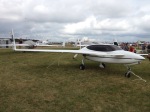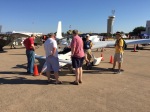Full Transcript
This is Matt Croydon and you are listening to The Tinycast.
When I was a kid, maybe 7 or 8 years old, I was given the best gift ever. It was a little notebook, but it wasn’t just any notebook. It was about the size of an index card. It was green. A really bright green. And on it, on the front cover, in a really bright yellow, was a stegosaurus. In bright yellow print, just below it, was the word stegosaurus, just in case you couldn’t figure it out on your own.
It was special.
It was actually too special.
I liked that notebook so much that I didn’t want to write or draw something inside it that wasn’t perfect. It deserved better than that.
And so it sat there.
I kept thinking about what I wanted to write in that notebook, but nothing worthy of it ever came to mind. I wrote in and on other things. I drew pictures and stuff like that. Just not in that notebook.
It sat there for years. On my bookshelf, and eventually in my “junk drawer,” a kind of catch all drawer in my dresser for stuff that didn’t have a better home. It lived alongside this sweet British Petrolium ashtray featuring a Brontosaurus, back from when the Brontosaurus was still a thing, and probably from that time after BP bought some assets from the Sinclair Oil Corporation on the east coast.
And it really just sat there for years. When I was in high school or so, I finally cleaned out my junk drawer, moving the most precious of stuff and memories to a box. I came across the stegosaurs notebook, and kinda thought about it for a second. And then I realized that I was never going to come up with something good enough for that notebook. I was never going to write or draw in that notebook.
So I threw it out.
I think about that notebook when I’m working on something and not calling it done because it’s not perfect. Or when I’m not working on something because I’m not sure how to make it perfect.
I’m thinking about it right now, as I’m talking to you, standing in front of a microphone in a walk-in closet. It’s why I’ll score this and mix this and release it before it’s perfect.
Because if I wait for it to be perfect, it will become a perfect stegosaurus notebook. Empty. In the trashcan.
This is Matt Croydon and you’re listening to The Tinycast. It’s a podcast that is short, sweet, and to the point. It may not be perfect but it’s fun to produce and I hope fun to listen to as well. If you have any thoughts or comments I’d love to hear from you.
Music for today’s show includes the instrumental versions of River Went Dry, Private Hurricane, and Crazy Glue by Josh Woodward. You can hear more of his music at joshwoodward.com.
You can find us on the web at tinycast.in, on twitter @thetinycast, soundcloud.com/tinycast, and at purveyors of podcast directories everywhere. You can find me on twitter, @mc. Episodes are also available at the Public Radio Exchange, PRX.org.
Music
- Music – “River Went Dry” by Josh Woodward. Free download: http://joshwoodward.com/song/RiverWentDry
- Music – “Private Hurricane” by Josh Woodward. Free download: http://joshwoodward.com/song/PrivateHurricane
- Music – “Crazy Glue” by Josh Woodward. Free download: http://joshwoodward.com/song/CrazyGlue
Production Notes
Recorded in my walk-in closet with a Shure KSM-32 on the TASCAM DR-44WL in more takes than a four minute podcast requires. Mixed in Auria with Fabfilter Pro-C and Pro-Q on an iPad 3.



